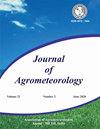埃塞俄比亚奥罗米亚地区厄尔尼诺年气象干旱的时空分析
Q3 Agricultural and Biological Sciences
引用次数: 0
摘要
干旱是全球最常见的自然灾害之一,对环境、经济和社会状况产生重大影响,埃塞俄比亚也不例外,尤其是奥罗米亚地区。为了评估和描述奥罗米亚地区与厄尔尼诺现象有关的气象干旱,使用了卫星数据 CHIRPS。利用 GeoCLIM、地理信息系统和 Python 工具,使用标准化降水指数(SPI),包括 SPI3、SPI6、SPI9 和 SPI12 指数,对 1991 年至 2020 年期间的月度时间序列数据进行了气象干旱的时空分析。研究结果表明,厄尔尼诺年期间的气象干旱表明,在奥罗米亚地区发生的弱厄尔尼诺、中厄尔尼诺和强厄尔尼诺事件都在增加。在时间尺度上,干旱的频率和持续时间可视化地反映在时间步长的短期干旱指数上。三至十二个月的时间尺度时间气象干旱指数显示,气象干旱的干旱指数在程度、持续时间和频率上各不相同。总体而言,在其余区域分析中,SPI3 和 SPI6、SPI6 和 SPI12 以及 SPI9 和 SPI12 指数之间的气象干旱严重程度的相关性主要表现为研究区域内短至长时间尺度上相关值的递增。本文章由计算机程序翻译,如有差异,请以英文原文为准。
Spatiotemporal analysis of meteorological drought in El Niño years over Oromia region, Ethiopia
Drought is one of the most common natural disasters globally, having major impacts on environmental, economic, and social conditions and Ethiopia is no exception particularly the Oromia region. In order to evaluate and characterize the meteorological droughts associated with El Niño years over the Oromia region, the satellite data CHIRPS was used. The monthly time series data for the period from 1991 to 2020 was used for temporal and spatial analysis of meteorological drought using standardized precipitation index (SPI) across SPI3, SPI6, SPI9 and SPI12 indices using GeoCLIM, GIS, and Python tools. The results of this study show that meteorological droughts during the El Niño years indicated an increment across weak, moderate, and strong El Niño events over the Oromia region. The dryness was visualized with frequency and duration in time-scale across short-term drought indices in time steps. The time-scale temporal meteorological drought indices in three to twelve months show that the drought indices varied in magnitude, duration, and frequency in meteorological droughts. In general, the meteorological drought severity of correlation for the remaining zones analysis between SPI3 and SPI6, SPI6 and SPI12, and SPI9 and SPI12 indices was dominated by an increment of the correlation values over short to long timescales over the study area.
求助全文
通过发布文献求助,成功后即可免费获取论文全文。
去求助
来源期刊

Journal of Agrometeorology
农林科学-农艺学
CiteScore
1.40
自引率
0.00%
发文量
95
审稿时长
>12 weeks
期刊介绍:
The Journal of Agrometeorology (ISSN 0972-1665) , is a quarterly publication of Association of Agrometeorologists appearing in March, June, September and December. Since its beginning in 1999 till 2016, it was a half yearly publication appearing in June and December. In addition to regular issues, Association also brings out the special issues of the journal covering selected papers presented in seminar symposia organized by the Association.
 求助内容:
求助内容: 应助结果提醒方式:
应助结果提醒方式:


